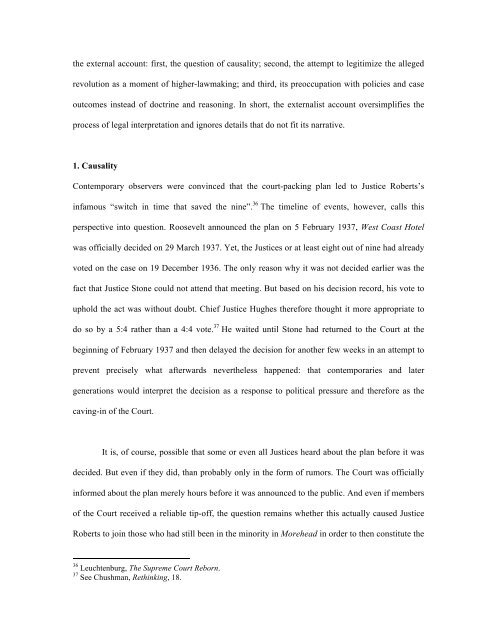Jasper Finke, Crisis and Law - New York University School of Law
Jasper Finke, Crisis and Law - New York University School of Law
Jasper Finke, Crisis and Law - New York University School of Law
You also want an ePaper? Increase the reach of your titles
YUMPU automatically turns print PDFs into web optimized ePapers that Google loves.
the external account: first, the question <strong>of</strong> causality; second, the attempt to legitimize the alleged<br />
revolution as a moment <strong>of</strong> higher-lawmaking; <strong>and</strong> third, its preoccupation with policies <strong>and</strong> case<br />
outcomes instead <strong>of</strong> doctrine <strong>and</strong> reasoning. In short, the externalist account oversimplifies the<br />
process <strong>of</strong> legal interpretation <strong>and</strong> ignores details that do not fit its narrative.<br />
1. Causality<br />
Contemporary observers were convinced that the court-packing plan led to Justice Roberts’s<br />
infamous “switch in time that saved the nine”. 36 The timeline <strong>of</strong> events, however, calls this<br />
perspective into question. Roosevelt announced the plan on 5 February 1937, West Coast Hotel<br />
was <strong>of</strong>ficially decided on 29 March 1937. Yet, the Justices or at least eight out <strong>of</strong> nine had already<br />
voted on the case on 19 December 1936. The only reason why it was not decided earlier was the<br />
fact that Justice Stone could not attend that meeting. But based on his decision record, his vote to<br />
uphold the act was without doubt. Chief Justice Hughes therefore thought it more appropriate to<br />
do so by a 5:4 rather than a 4:4 vote. 37 He waited until Stone had returned to the Court at the<br />
beginning <strong>of</strong> February 1937 <strong>and</strong> then delayed the decision for another few weeks in an attempt to<br />
prevent precisely what afterwards nevertheless happened: that contemporaries <strong>and</strong> later<br />
generations would interpret the decision as a response to political pressure <strong>and</strong> therefore as the<br />
caving-in <strong>of</strong> the Court.<br />
It is, <strong>of</strong> course, possible that some or even all Justices heard about the plan before it was<br />
decided. But even if they did, than probably only in the form <strong>of</strong> rumors. The Court was <strong>of</strong>ficially<br />
informed about the plan merely hours before it was announced to the public. And even if members<br />
<strong>of</strong> the Court received a reliable tip-<strong>of</strong>f, the question remains whether this actually caused Justice<br />
Roberts to join those who had still been in the minority in Morehead in order to then constitute the<br />
36 Leuchtenburg, The Supreme Court Reborn.<br />
37 See Chushman, Rethinking, 18.
















